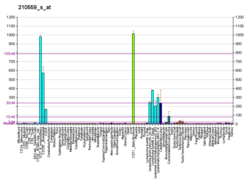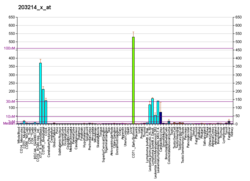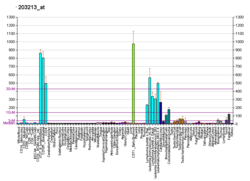サイクリン依存性キナーゼ1
サイクリン依存性キナーゼ1(サイクリンいぞんせいキナーゼ1、英: cyclin-dependent kinase 1、略称: CDK1)は高度に保存されたタンパク質で、セリン/スレオニンキナーゼとして機能する、細胞周期調節の主要因子である[5]。 cell division cycle protein 2 homolog(cdc2 homolog)とも呼ばれる。出芽酵母Saccharomyces cerevsiae、分裂酵母Schizosaccharomyces pombeでよく研究されており、それぞれcdc28とcdc2遺伝子にコードされている[6]。ヒトではCDK1はCDC2遺伝子にコードされている[7]。CDK1はサイクリンと複合体を形成してさまざまな標的基質をリン酸化し(出芽酵母では75種類を超える基質が同定されている)、細胞周期を進行させる[8]。
構造
[編集]CDK1は約 34 kDaの小さなタンパク質で、高度に保存されている。CDK1のヒトのホモログと酵母のホモログは約63%のアミノ酸配列が同一である。さらに、cdc2遺伝子に変異を有する酵母は、ヒトホモログによってレスキュー(変異体表現型からの回復)を行うことができる[7]。CDK1は、他のプロテインキナーゼにも共通して存在する、プロテインキナーゼモチーフのみによってほぼ構成されている。他のキナーゼと同様、CDK1にはATPが結合する溝が存在している。基質は溝の入り口付近に結合し、CDK1はATPのγ-リン酸と基質のセリン/スレオニン残基のヒドロキシル基の間の共有結合の形成を触媒する。
触媒コアに加えて、CDK1は他のサイクリン依存性キナーゼ(CDK)と同様に活性化ループ(Tループ)を持っている。サイクリンと相互作用していないときには、TループはCDK1の活性部位に基質が結合するのを防いでいる。また、CDK1はPSTAIREヘリックス(Cヘリックス)を持っている。このヘリックスはサイクリンの結合に伴って移動して活性部位を再配置し、CDK1のキナーゼ活性を促進する。これらの基本的機構はCDK2などの他のCDKと共通であるものの、具体的な相互作用様式はCDKごとに異なる[9][10]。
機能
[編集]
サイクリンと結合したCDK1によるリン酸化は、細胞周期の進行を引き起こす。CDK1の活性は出芽酵母S. cerevisiaeで最もよく理解が進んでいるため、ここではS. cerevisiaeのCdk1(Cdc28)の活性について記述する[5]。
出芽酵母では、細胞周期の進行の開始は、SBF(SCB-binding factor)とMBF(MCB-binding factor)という2つの調節複合体によって制御されている。これらの2つの複合体はG1/S期の遺伝子の転写を制御するが、通常は不活性状態である。SBFはWhi5によって阻害されているが、Cln3-Cdk1(脊椎動物ではサイクリンD)によるリン酸化によってWhi5は核から搬出され、G1/Sレギュロンの転写が行われる。このレギュロンにははG1/S期のサイクリンCln1、2(脊椎動物ではサイクリンE)が含まれている[11]。G1/S期サイクリン-Cdk1の活性によってS期へ進行するための準備(中心体の複製など)が行われ、S期サイクリン(Clb5、6、脊椎動物ではサイクリンA)のレベルが上昇する。S期サイクリン-Cdk1複合体は直接的に複製起点の初期化を行うが[12]、尚早なS期の開始はSic1によって防がれている。
G1/S期サイクリンまたはS期サイクリン-Cdk1複合体の活性によってSic1のレベルは急激に低下し、S期への進行が行われる。その後、M期サイクリン(Clb1、2、3、4など、脊椎動物ではサイクリンB)とCdk1との複合体によるリン酸化が紡錘体の組み立てや姉妹染色分体の分離を引き起こす。また、Cdk1によるリン酸化はユビキチンリガーゼであるAPCCdc20も活性化し、染色分体の分離や、さらにはM期サイクリンの分解を活性化する。このM期サイクリンの破壊によって、有糸分裂の最終段階(紡錘体の解体など)が引き起こされる。
調節
[編集]CDK1はサイクリンの結合によって調節されている。サイクリンの結合によってCDK1の活性部位へのアクセスが変化し、CDK1はキナーゼ活性を発揮できるようになる。さらに、サイクリンはCDK1の活性に特異性を付与する。少なくとも一部のサイクリンには基質と直接相互作用する疎水的パッチが存在し、それによって標的特異性が得られている[13]。サイクリンは、特定の細胞内部位へのCDK1の標的化を行うこともある。
サイクリンによる調節に加えて、CDK1はリン酸化によっても調節されている。保存されたチロシン残基(ヒトではTyr15)のリン酸化はCDK1を阻害する。このリン酸化によってATPの結合配向が変化し、効率的なキナーゼ活性が阻害されると考えられている。分裂酵母S. pombeでは、DNA合成が完了していないときにはこのリン酸化が安定化され、有糸分裂の進行は防がれる[14]。すべての真核生物に保存されているWee1がTyr15のリン酸化を行い、Cdc25ファミリーのメンバーのホスファターゼがこの活性に拮抗する。これらの因子間のバランスによって細胞周期の進行は制御されていると考えられている。Wee1はさらに上流のCdr1、Cdr2、Pom1などの因子によって制御されている。
CDK1-サイクリン複合体は、CDK阻害因子の直接的な結合によっても制御されている。このようなタンパク質の1つが上述したSic1である。Sic1はS期サイクリンClb5,6-Cdk1複合体に直接結合して阻害を行う因子である。 G1/S期サイクリンCln1,2-Cdk1によるSic1の複数箇所のリン酸化は、Sic1のユビキチン化と分解のタイミング、すなわちS期への進行のタイミングを決定していると考えられている。Sic1による阻害が克服されたときにのみClb5,6の活性が生じ、S期が開始される。
相互作用
[編集]CDK1は次に挙げる因子と相互作用することが示されている。
出典
[編集]- ^ a b c GRCh38: Ensembl release 89: ENSG00000170312 - Ensembl, May 2017
- ^ a b c GRCm38: Ensembl release 89: ENSMUSG00000019942 - Ensembl, May 2017
- ^ Human PubMed Reference:
- ^ Mouse PubMed Reference:
- ^ a b c Morgan, David L. (2007). The cell cycle: principles of control. London: New Science Press. pp. 30–31. ISBN 978-0-19-920610-0
- ^ “Control of the yeast cell cycle by the Cdc28 protein kinase”. Curr. Opin. Cell Biol. 5 (2): 166–179. (April 1993). doi:10.1016/0955-0674(93)90099-C. PMID 8507488.
- ^ a b Lee, Melanie; Nurse, Paul (Jun 1987). “Complementation used to clone a human homologue of the fission yeast cell cycle control gene cdc2”. Nature 327 (6117): 31–35. doi:10.1038/327031a0. PMID 3553962.
- ^ “An overview of Cdk1-controlled targets and processes”. Cell Division 5 (11): 11. (May 2010). doi:10.1186/1747-1028-5-11. PMC 2876151. PMID 20465793.
- ^ “Mechanism of CDK activation revealed by the structure of a cyclinA-CDK2 complex”. Nature 376 (6538): 313–320. (July 1995). doi:10.1038/376313a0. PMID 7630397.
- ^ Brown, Nicholas R.; Korolchuk, Svitlana; Martin, Mathew P.; Stanley, Will A.; Moukhametzianov, Rouslan; Noble, Martin E. M.; Endicott, Jane A. (2015-04-13). “CDK1 structures reveal conserved and unique features of the essential cell cycle CDK”. Nature Communications 6: 6769. doi:10.1038/ncomms7769. ISSN 2041-1723. PMC 4413027. PMID 25864384.
- ^ “Positive feedback of G1 cyclins ensures coherent cell cycle entry”. Nature 454 (7202): 291–296. (July 2008). doi:10.1038/nature07118. PMC 2606905. PMID 18633409.
- ^ “Specialization and targeting of B-type cyclins”. Mol Cell 4 (1): 11–19. (July 1999). doi:10.1016/S1097-2765(00)80183-5. PMID 10445023.
- ^ “The structural basis for specificity of substrate and recruitment peptides for cyclin-dependent kinases”. Nat. Cell Biol. 1 (7): 438–443. (November 1999). doi:10.1038/15674. PMID 10559988.
- ^ “Cell cycle checkpoints: preventing an identity crisis”. Science 274 (5293): 1664–1672. (December 1996). doi:10.1126/science.274.5293.1664. PMID 8939848.
- ^ “Microtubule-targeting drugs induce bcl-2 phosphorylation and association with Pin1”. Neoplasia 3 (6): 550–9. (2001). doi:10.1038/sj.neo.7900213. PMC 1506558. PMID 11774038.
- ^ “Microtubule-targeting drugs induce Bcl-2 phosphorylation and association with Pin1”. Neoplasia 3 (1): 70–9. (2001). doi:10.1038/sj.neo.7900131. PMC 1505024. PMID 11326318.
- ^ a b “Cyclin E associates with BAF155 and BRG1, components of the mammalian SWI-SNF complex, and alters the ability of BRG1 to induce growth arrest”. Mol. Cell. Biol. 19 (2): 1460–9. (February 1999). doi:10.1128/mcb.19.2.1460. PMC 116074. PMID 9891079.
- ^ “Isolation of a human cyclin cDNA: evidence for cyclin mRNA and protein regulation in the cell cycle and for interaction with p34cdc2”. Cell 58 (5): 833–846. (September 1989). doi:10.1016/0092-8674(89)90936-7. PMID 2570636.
- ^ “Cyclin F regulates the nuclear localization of cyclin B1 through a cyclin-cyclin interaction”. EMBO J. 19 (6): 1378–1388. (March 2000). doi:10.1093/emboj/19.6.1378. PMC 305678. PMID 10716937.
- ^ “Formation and activation of a cyclin E-cdk2 complex during the G1 phase of the human cell cycle”. Science 257 (5077): 1689–1694. (September 1992). doi:10.1126/science.1388288. PMID 1388288.
- ^ “KAP: a dual specificity phosphatase that interacts with cyclin-dependent kinases”. Proc. Natl. Acad. Sci. U.S.A. 91 (5): 1731–1735. (March 1994). doi:10.1073/pnas.91.5.1731. PMC 43237. PMID 8127873.
- ^ “Cdi1, a human G1 and S phase protein phosphatase that associates with Cdk2”. Cell 75 (4): 791–803. (November 1993). doi:10.1016/0092-8674(93)90498-F. PMID 8242750.
- ^ “Cell cycle-dependent phosphorylation of Disabled-2 by cdc2”. Oncogene 22 (29): 4524–4530. (July 2003). doi:10.1038/sj.onc.1206767. PMID 12881709.
- ^ “Yeast two-hybrid screens imply involvement of Fanconi anemia proteins in transcription regulation, cell signaling, oxidative metabolism, and cellular transport”. Exp. Cell Res. 289 (2): 211–221. (October 2003). doi:10.1016/S0014-4827(03)00261-1. PMID 14499622.
- ^ “The Fanconi anemia polypeptide, FAC, binds to the cyclin-dependent kinase, cdc2”. Blood 90 (3): 1047–54. (August 1997). PMID 9242535.
- ^ “Association with Cdc2 and inhibition of Cdc2/Cyclin B1 kinase activity by the p53-regulated protein Gadd45”. Oncogene 18 (18): 2892–2900. (May 1999). doi:10.1038/sj.onc.1202667. PMID 10362260.
- ^ “The GADD45 inhibition of Cdc2 kinase correlates with GADD45-mediated growth suppression”. J. Biol. Chem. 275 (22): 16602–16608. (June 2000). doi:10.1074/jbc.M000284200. PMID 10747892.
- ^ “Identification of a functional domain in a GADD45-mediated G2/M checkpoint”. J. Biol. Chem. 275 (47): 36892–36898. (November 2000). doi:10.1074/jbc.M005319200. PMID 10973963.
- ^ “GADD45b and GADD45g are cdc2/cyclinB1 kinase inhibitors with a role in S and G2/M cell cycle checkpoints induced by genotoxic stress”. J. Cell. Physiol. 192 (3): 327–338. (September 2002). doi:10.1002/jcp.10140. PMID 12124778.
- ^ “Human homologue of the Drosophila melanogaster lats tumour suppressor modulates CDC2 activity”. Nat. Genet. 21 (2): 177–181. (February 1999). doi:10.1038/5960. PMID 9988268.
- ^ “Activation of Src-like p56/p53lyn tyrosine kinase by ionizing radiation”. J. Biol. Chem. 269 (32): 20739–43. (August 1994). PMID 8051175.
- ^ “The protein-tyrosine kinase Lck associates with and is phosphorylated by Cdc2”. J. Biol. Chem. 271 (44): 27517–27523. (November 1996). doi:10.1074/jbc.271.44.27517. PMID 8910336.
- ^ “The C-terminal regulatory domain of p53 contains a functional docking site for cyclin A”. J. Mol. Biol. 300 (3): 503–518. (July 2000). doi:10.1006/jmbi.2000.3830. PMID 10884347.
- ^ “Downregulation of the cdc2/cyclin B protein kinase activity by binding of p53 to p34(cdc2)”. Biochem. Biophys. Res. Commun. 283 (2): 507–512. (May 2001). doi:10.1006/bbrc.2001.4792. PMID 11327730.
- ^ “Proteomic analysis of ubiquitinated proteins in normal hepatocyte cell line Chang liver cells”. Proteomics 8 (14): 2885–2896. (July 2008). doi:10.1002/pmic.200700887. PMID 18655026.
関連文献
[編集]- “Cdc25 protein phosphatases in cell proliferation”. Biochim. Biophys. Acta 1332 (2): M53–63. (1997). doi:10.1016/S0304-419X(96)00049-2. PMID 9141461.
- “Partner molecules of accessory protein Vpr of the human immunodeficiency virus type 1”. DNA Cell Biol. 23 (4): 193–205. (2004). doi:10.1089/104454904773819789. PMID 15142377.
- “Human immunodeficiency virus type-1 accessory protein Vpr: a causative agent of the AIDS-related insulin resistance/lipodystrophy syndrome?”. Ann. N. Y. Acad. Sci. 1024: 153–167. (2004). doi:10.1196/annals.1321.013. PMID 15265780.
- “Structure and function of HIV-1 auxiliary regulatory protein Vpr: novel clues to drug design”. Curr. Drug Targets Immune Endocr. Metabol. Disord. 4 (4): 265–275. (2005). doi:10.2174/1568008043339668. PMID 15578977.
- “The Vpr protein from HIV-1: distinct roles along the viral life cycle”. Retrovirology 2: 11. (2006). doi:10.1186/1742-4690-2-11. PMC 554975. PMID 15725353.
- “Viral infections and cell cycle G2/M regulation”. Cell Res. 15 (3): 143–149. (2005). doi:10.1038/sj.cr.7290279. PMID 15780175.
- “HIV-1 viral protein R (Vpr) & host cellular responses”. Indian J. Med. Res. 121 (4): 270–86. (2005). PMID 15817944.
- “Cell cycle sibling rivalry: Cdc2 vs. Cdk2”. Cell Cycle 4 (11): 1491–1494. (2007). doi:10.4161/cc.4.11.2124. PMID 16258277.
- “Roles of HIV-1 auxiliary proteins in viral pathogenesis and host-pathogen interactions”. Cell Res. 15 (11–12): 923–934. (2006). doi:10.1038/sj.cr.7290370. PMID 16354571.
- “[Biologic availability and "1st pass" effect of drugs]”. Fortschr. Med. 95 (28): 1765–6, 1774–80. (1977). PMID 914146.
- “Interaction between the cell-cycle-control proteins p34cdc2 and p9CKShs2. Evidence for two cooperative binding domains in p9CKShs2”. Eur. J. Biochem. 203 (3): 353–360. (1992). doi:10.1111/j.1432-1033.1992.tb16557.x. PMID 1310466.
- “cdc2 family kinases phosphorylate a human cell DNA replication factor, RPA, and activate DNA replication”. EMBO J. 11 (6): 2189–99. (1992). doi:10.1002/j.1460-2075.1992.tb05278.x. PMC 556686. PMID 1318195.
- “Formation and activation of a cyclin E-cdk2 complex during the G1 phase of the human cell cycle”. Science 257 (5077): 1689–1694. (1992). doi:10.1126/science.1388288. PMID 1388288.
- “Casein kinase II phosphorylates p34cdc2 kinase in G1 phase of the HeLa cell division cycle”. J. Biol. Chem. 267 (28): 20317–25. (1992). PMID 1400350.
- “Localization of the rap1GAP catalytic domain and sites of phosphorylation by mutational analysis”. Mol. Cell. Biol. 12 (10): 4634–42. (1992). doi:10.1128/MCB.12.10.4634. PMC 360390. PMID 1406653.
- “Reversible phosphorylation--dephosphorylation determines the localization of rab4 during the cell cycle”. EMBO J. 11 (12): 4379–89. (1992). doi:10.1002/j.1460-2075.1992.tb05538.x. PMC 557012. PMID 1425574.
- “A phosphorylation site located in the NH2-terminal domain of c-Myc increases transactivation of gene expression”. J. Biol. Chem. 266 (35): 23521–4. (1992). PMID 1748630.
- “The retinoblastoma protein is phosphorylated on multiple sites by human cdc2”. EMBO J. 10 (13): 4279–90. (1992). doi:10.1002/j.1460-2075.1991.tb05006.x. PMC 453181. PMID 1756735.
- “Regional assignment of the human cell cycle control gene CDC2 to chromosome 10q21 by in situ hybridization”. Hum. Genet. 87 (5): 621–2. (1991). doi:10.1007/BF00209025. PMID 1916766.
- “Phosphorylation by cdc2 kinase modulates DNA binding activity of high mobility group I nonhistone chromatin protein”. J. Biol. Chem. 266 (30): 19945–52. (1991). PMID 1939057.








